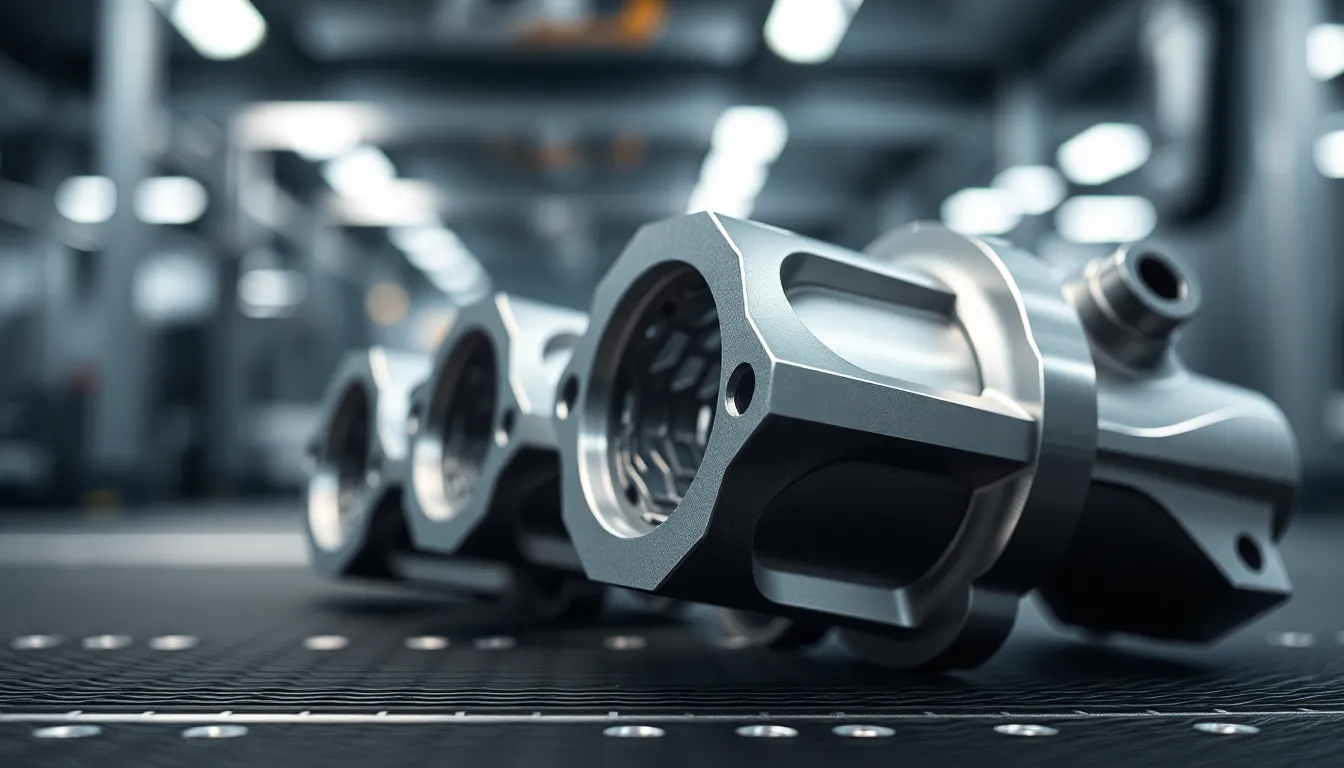In the fast-paced world of manufacturing, SLM 3D printing is the superhero no one saw coming. It’s like the Swiss Army knife of production techniques, capable of transforming digital designs into solid metal parts with just a sprinkle of laser magic. Imagine crafting complex geometries that would make even the most seasoned engineers raise an eyebrow.
But don’t let the technical jargon scare you off! SLM, or Selective Laser Melting, is here to make manufacturing not just efficient but downright exciting. It’s revolutionizing industries from aerospace to healthcare, proving that even the most serious sectors can have a little fun. So buckle up and get ready to dive into the world of SLM 3D printing, where innovation meets imagination, and the only limit is how wild your ideas can get.
Table of Contents
ToggleWhat Is SLM 3D Printing?
SLM 3D printing, also known as Selective Laser Melting, represents a significant advancement in manufacturing technology. This process utilizes high-powered lasers to fuse powdered metal layers, resulting in strong and precise components. In industries like aerospace, automotive, and healthcare, SLM’s ability to produce intricate parts with high fidelity leads to innovative design possibilities.
Materials suitable for SLM printing include titanium, aluminum, and stainless steel, allowing for a range of applications. Designers create complex geometries that traditional manufacturing methods cannot achieve. The rapid prototyping capabilities of SLM also reduce time from concept to final product.
Unlike traditional machining, SLM minimizes waste by using only the necessary amount of material. Each layer is built precisely, reducing excess scrap and lowering material costs. Additionally, the process allows for customizability, enabling tailored solutions based on specific project requirements.
Efficiency in production stands out as another advantage of SLM 3D printing. It facilitates the rapid creation of parts, optimizing lead times significantly compared to conventional methods. Quality control remains crucial, with stringent monitoring ensuring that the properties of printed components align with industry standards.
As manufacturing evolves, SLM continues to drive innovation. By exploring the capabilities of SLM 3D printing, industries can enhance product performance, reduce costs, and embrace design freedom. This technology is paving the way for the future of manufacturing.
Advantages of SLM 3D Printing

SLM 3D printing offers multiple benefits that enhance manufacturing capabilities across various industries. The advanced technology enables the production of complex parts with unmatched efficiency and customizability.
High Precision and Detail
High precision defines SLM 3D printing. This method achieves intricate geometries that traditional manufacturing often struggles to replicate. Lasers meticulously target powdered metal, ensuring layers are fused with remarkable accuracy. The ability to create features like tiny channels or complex lattice structures enhances overall design functionality. Industries such as aerospace and healthcare benefit, as precise components directly impact performance and reliability. This consistency enables engineers to turn their most ambitious designs into reality, resulting in custom parts tailored for specific applications.
Material Efficiency
Material efficiency stands out as a key advantage of SLM 3D printing. This technique minimizes waste by only using the exact amount of material required for each component, unlike conventional methods that often generate significant scrap. By leveraging powdered metals, SLM allows excess powder to be reused in future prints, further contributing to resource conservation. Industries looking to reduce costs and environmental impact find this particularly appealing. Enhanced material utilization also enables designers to explore innovative shapes without concern for waste, leading to both creative breakthroughs and economic benefits.
Applications of SLM 3D Printing
SLM 3D printing showcases numerous applications across various industries due to its design flexibility and material efficiency. Key sectors benefiting from this technology include aerospace and healthcare.
Aerospace Industry
Aerospace manufacturers utilize SLM 3D printing to create components that meet stringent weight and strength requirements. This technology fabricates parts such as fuel nozzles and engine brackets, enabling engineers to develop lightweight yet robust designs. Additionally, SLM allows for the production of complex geometries that traditional methods struggle to achieve, like lattice structures. Parts made using SLM exhibit enhanced performance in extreme conditions typical of flight environments. By reducing material waste and optimizing lead times, aerospace companies significantly lower production costs, enhancing overall efficiency.
Medical Field
In the medical field, SLM 3D printing revolutionizes the manufacturing of prosthetics and implants. Customization plays a crucial role, as devices can be tailored to fit individual patient anatomies perfectly. Surgeons benefit from creating intricate models for preoperative planning, improving surgical outcomes. SLM produces biocompatible components, essential for implants used in various procedures. Furthermore, the rapid prototyping capability allows for quicker iterations, ensuring innovation aligns with evolving medical standards. As a result, medical professionals experience enhanced capabilities in providing personalized patient care.
The SLM 3D Printing Process
SLM 3D printing involves several precise steps to convert digital files into solid metal components. Initially, engineers prepare a 3D model using CAD software. Next, powdered metal, such as titanium or aluminum, fills the build chamber.
Step-by-Step Overview
Layers of powder spread evenly across the build platform. A high-powered laser then scans the surface, melting the powder according to the specified design. As one layer solidifies, the platform lowers, and another powder layer follows. This procedure repeats until the final part is complete, ensuring strong and complex geometries are achieved throughout the process. Post-processing may include cleaning and heat treatment to enhance mechanical properties.
Key Technologies Involved
Key technologies in SLM 3D printing include powerful laser systems that provide high energy to melt metal powder effectively. Control software manages laser movement and ensures accuracy in the melting process. Additionally, powder handling systems maintain the flow and distribution of the metal powder, crucial for achieving consistent results. Advanced monitoring systems track temperature and quality throughout the build, promoting adherence to industry standards. These technologies collectively enhance the efficiency and reliability of the SLM 3D printing process, making it a preferred choice for many modern manufacturing applications.
Challenges in SLM 3D Printing
SLM 3D printing faces several challenges that impact its adoption and efficiency. High costs associated with equipment and materials pose significant barriers to entry. Initial investments for machinery and powder can be substantial, limiting access for smaller enterprises.
Complexity in the process adds another layer of difficulty. Operators must possess specialized skills to manage the technology, requiring training and expertise. If these skills aren’t available, it may lead to inconsistent quality and production delays.
Material limitations also exist. Some metal powders used in SLM may not be readily available or suitable for every application, which can restrict design options. The necessity for specific material properties may limit creativity in prototyping.
Post-processing requirements contribute to operational challenges. Most SLM parts require additional finishing steps to achieve desired surface quality or mechanical properties. These post-processing tasks can extend lead times and complicate production workflows.
Quality control remains a critical aspect that can be difficult to manage. Ensuring each layer fuses correctly demands rigorous monitoring throughout the printing process. Inadequate control can result in defects, impacting overall reliability and performance.
Lastly, production scalability proves to be a challenge. While SLM excels in creating intricate parts, scaling up to mass production remains complex. Companies may struggle to transition from small runs to larger volumes while maintaining quality and efficiency.
These challenges highlight the need for ongoing innovation and development in SLM 3D printing, positioning the technology for a more prominent role in manufacturing.
SLM 3D printing stands at the forefront of modern manufacturing with its ability to create complex and precise metal components. This technology not only enhances efficiency but also opens doors to innovative designs that traditional methods can’t achieve. As industries like aerospace and healthcare continue to adopt SLM, its impact on production processes will only grow.
Despite challenges such as high costs and the need for specialized skills, the advantages of SLM 3D printing are undeniable. With ongoing advancements and a focus on overcoming these hurdles, SLM is set to revolutionize how products are designed and manufactured. Embracing this technology means embracing a future filled with possibilities.



